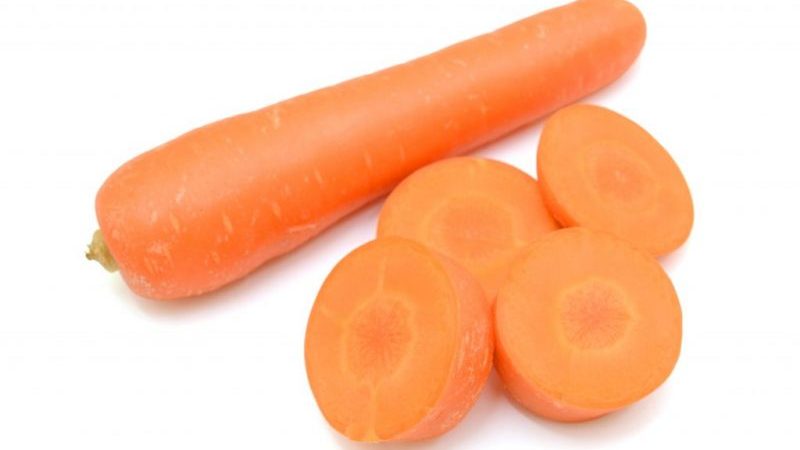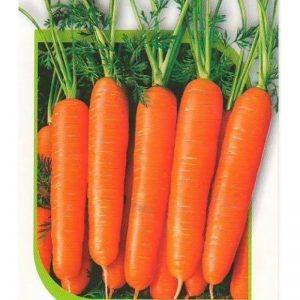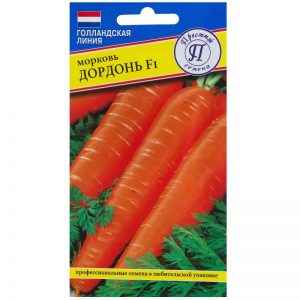Early maturing, cold-tolerant hybrid of Dordogne carrots
Dordogne F1 is a hybrid of carrots, characterized by high yield and keeping quality. Its popularity is due to the excellent presentation of root crops, which in most cases look perfect.
How to grow hybrid on a personal site - read the article.
The content of the article
Description of the hybrid carrot Dordogne
Dordogne is an early ripening stress-resistant hybrid. This vegetable crop is popular in the Russian Federation; it is grown on an industrial scale. The hybrid has a high yield: 75 tons of carrots are harvested from 1 hectare.
Orange cylindrical roots have an excellent presentation. The marketability indicator reaches 95%. The vegetable is juicy.
Reference. Hybrid ideal for making juices and purees.
Root crops can be stored for 8-10 months without losing their shape and taste.

Origin and development
Dordogne (Dordogne F1) is a hybrid of the Nantes cultivar, bred by the Dutch breeders of the Syngenta company. Since the beginning of the XXI century, this vegetable crop has been zoned and recommended for cultivation in the northern regions of the Russian Federation.
Chemical composition, trace elements and vitamins, useful properties
The Dordogne is characterized by the richest chemical composition. Orange root vegetables contain vitamins C, E, K and group B.
The vegetable is rich in beta-carotene (12%), which is converted in the human body into retinol - a powerful antioxidant that has a beneficial effect on lung function.
An orange vegetable is rich in potassium, iron, phosphorus, magnesium, iodine, zinc and other minerals.
Dordogne carrots have a specific aroma thanks to essential oils. Roots contain a lot of fructose and sugars - 7%.
Eating a hybrid carrot contributes to:
- strengthening immunity;
- healing burns and purulent wounds (a grated vegetable can be applied to problem areas of the skin);
- bowel cleansing;
- improving the functioning of the digestive tract, liver;
- getting rid of helminths;
- improving vision.
The vegetable is recommended for people suffering from anemia. Its regular use is the prevention of myocardial infarction. It is suitable for dietary nutrition due to its low calorie content - 35 kcal.
Ripening period
Dordogne is an early ripe carrot. The ripening period is from 115 to 140 days, depending on the climatic conditions of the growing region and the quality of care of the vegetable crop.
Yield
The hybrid is characterized by a consistently high yield: from 1 m² are harvested from 3.5 to 7.5 kg of carrots (from 1 ha - up to 75 tons). The quality of the crop is practically independent of external factors.
Disease resistance
Dordogne is a hybrid with a high degree of disease resistance. Plants are rarely affected by disease. This can only happen in the case of illiterate care.
Characteristics, description of appearance, taste
Dordogne carrots are characterized by a loose, erect rosette with small leaves of a rich green color, belonging to the dissected type. The hybrid is not prone to shooting.
It is characterized by selected root crops aligned in shape and size. The number of deformed carrots deviating from the standard sizes does not exceed 5%. The hybrid is not prone to cracking and overgrowing the fruit.
It is characterized by the correct cylindrical shape of the fruit with a blunt end. The surface is smooth, has a uniform intense orange color. The internal structure of carrots is characterized by uniformity. It does not have a pronounced coarse core. The top is never green. The length of the carrot reaches 20 cm, in diameter - 6 cm.Weighs from 70 to 120 g.
The Dordogne has a pleasant taste. The pulp is not fibrous, it is juicy and sweet. The taste of carrots is similar to the Nantes variety.
Important. After mechanical washing, carrots do not darken, retains color uniformity.
Which regions is best suited for
The hybrid is suitable for growing in all regions of the Russian Federation, including the northern ones. The Dordogne grows both in open ground and greenhouse conditions.
The main advantages and disadvantages of a hybrid
The advantages of the Dordogne hybrid:
- high resistance to diseases and pests;
- unpretentiousness to soil quality and the ability to adapt to temperature extremes, different weather conditions;
- high yield rate;
- attractive appearance and pleasant taste;
- excellent keeping quality and transportability of root crops;
- high marketability rate of 95%;
- resistance of root crops to mechanical damage.
There were no drawbacks in the hybrid.
What is the difference from others
The hybrid Dordogne compares favorably with other varieties of carrots not only by its high yield, but also by its resistance to cracking and mechanical damage, and frost resistance.
Comparative characteristics of the most common varieties and hybrids of carrots.
| Name | Ripening terms | Yield indicator, kg / m2 | Indicators of length (cm) and weight (g) of root crops |
| Dordogne | early maturing | 7,5 | 20
70-120 |
| Vita longa | early maturing | 5 | 24
90-128 |
| Chantenay 1246 | mid-season | 3-6 | 20
120-200 |
| Crunch | early | 3 | 17-20
90-150 |
| Malika | mid-late | 4,5 | 16
90-180 |
| Sentyabrina | mid-season | 5-7 | 14-18
90-190 |
Features of planting and growing
Compliance with the rules of planting and care is the key to a rich harvest. It is not recommended to grow the Dordogne on the same plot for more than 3 years in a row. Otherwise, the susceptibility of plants to diseases and pests increases.
Preparing for landing

On the eve of planting, it is important to prepare the soil. In the autumn, it is cleaned of plant residues, dug up. Carrots grow better in a lighted area. It is better to avoid shadows and waterlogged soil.
Pre-preparation is not necessary for granulated seeds. Watering is enough for them when planting. It is recommended to soak ordinary seeds for 1 day in warm water.
Ground requirements
To get a good harvest, you need a non-acidic soil. It is recommended to add slaked lime to the soil with a high acidity:
- in the sand - 3-4 kg per 1 m²;
- in clay - 5-7 kg per 1 m².
Heavy clay soil will need to be loosened and sawdust added.
Predecessors
After beets, celery, dill and parsley, carrots are not grown. It is preferable to grow it in an area where onions, cabbage or cucumbers used to grow.
Timing, scheme and landing rules
In the southern part of the country and the central strip, the Dordogne is planted in the first half of April, and in the northern regions in May... The optimum soil temperature is not less than + 4 ... + 6 ° С. Favorable temperature conditions for carrot growth + 18… + 25 ° С. The culture is afraid of frost, at -5 ° C it dies.
The seeds are planted in grooves with a depth of 2 cm. The distance between the rows is 20-25 cm. The distance between the seeds should be at least 5 cm. Then the bed is watered, peat is poured between the rows.
No more than 110 seeds are required per 1 m² of soil.The germination rate of the hybrid is high - up to 95%.
Growing features
The vegetable culture is unpretentious. Hybrid agricultural technology necessarily includes:
- carrying out deep autumn plowing of the soil so that the roots can develop to a depth of 0.3 m;
- fertilization before sowing and during the growing season;
- landing without excessive thickening;
- ensuring rare watering, repeated loosening and mulching of the beds.
The nuances of care
The use of mulch is an important care nuance that reduces the number of waterings. Plants also need loosening and weeding.
Watering mode
The Dordogne does not require frequent watering. It is recommended to water with warm water once every 10 days.
Important! Watering is stopped 3 weeks before harvesting.
Thinning and weed control
Removing weeds is a must. Weed carefully, trying not to touch the seedlings.
Thin twice: as soon as the shoots appeared and after a month. Weak seedlings are removed. A distance of 4-6 cm is left between the plants. With the second thinning, it is increased to 6-7 cm.
Top dressing
For the first time, fertilizers diluted with water are applied at the beginning of the growing season. Dissolve in 10 liters of water:
- ammonium nitrate - 30 g;
- potassium salt - 15 g;
- "Superphosphate" - 10 g.
After 20 days, planting is watered with a solution of wood ash (450 g per 10 l).
Attention! You cannot fertilize carrots with manure; mineral fertilizing is preferable.
Disease and pest control
Errors in agrotechnology increase the risk of disease and pest damage to plants. In such cases, the following methods are applicable:
- spraying with a safe biological preparation "Gamair" in dry weather helps against root rot;
- from the carrot fly use the "Confidor" remedy.
Harvesting and storage
Proper collection and suitable storage conditions guarantee good keeping quality of carrots.
How and when to collect
Carrots are harvested in early August in dry and warm weather. They clean the ground from root crops, leave them to dry.
Mechanized harvesting of Dordogne carrots is acceptable. However, it is preferable to harvest by hand, pulling root crops out of the ground.
Storage features and keeping quality of the hybrid
The harvest is stored in a basement or cellar at a temperature not lower than + 4 ° C. The room must be dry and ventilated. Root crops are kept in ventilated boxes. The shelf life is up to 10 months.
Read also:
How to properly prepare pickled cucumbers with carrots for the winter.
How to cook pickled eggplant stuffed with carrots and garlic.
What can be the difficulties in growing
Problems when growing a hybrid can arise due to incorrect planting care:
- The taste of carrots is bitter... The reason is the exposure of the upper part of the root crop. The solution is to sprinkle the protruding vegetable with earth and thin out the rows.
- Carrots grow irregularly shaped. The reason is organic fertilization or heavy, rocky soil. The solution is the use of mineral fertilizers and the choice of light soil.
- Root overgrowth with roots, as a result - deterioration of keeping quality. The reason is a lack of moisture and nutrients. The solution is moderate watering and good quality land.
Tips from experienced gardeners
To increase the germination of the seeds of this hybrid, experienced gardeners advise:
- rinse the seed for 10 minutes in hot water with a temperature of +45 to + 50 ° C;
- harden the seeds before sowing.
The first feeding of young seedlings to improve the quality of the crop is carried out when 3-4 leaves appear on the tops.
Farmers reviews
Reviews of the Dordogne carrot hybrid are positive, since the vegetable does not need labor-intensive care and always gives a good harvest.
Oksana, Tula: “I grow carrots for sale. For five years now I have been planting Dordogne carrots in the beds. This is a win-win for me. My site is located in the steppe zone, and the soil on it is not fertile. Despite this, the harvest is good. There are very few non-commercial carrots. "
Sergey, Saratov: "My land plot is located in the lowlands. Moisture often accumulates there, the soil dries out poorly. Sour soil. In the fall I dig up the beds, in the spring - the harrow. Carrots grow excellent. The bad news is that my site is small, I have to plant in the same place for four years in a row. However, this does not affect the yield. "
Conclusion
The Dordogne carrot hybrid has excellent characteristics and taste. Cultivation and care does not take much time and labor. The harvest is always of high quality and presentation. The culture is suitable both for cultivation for sale and for personal purposes.